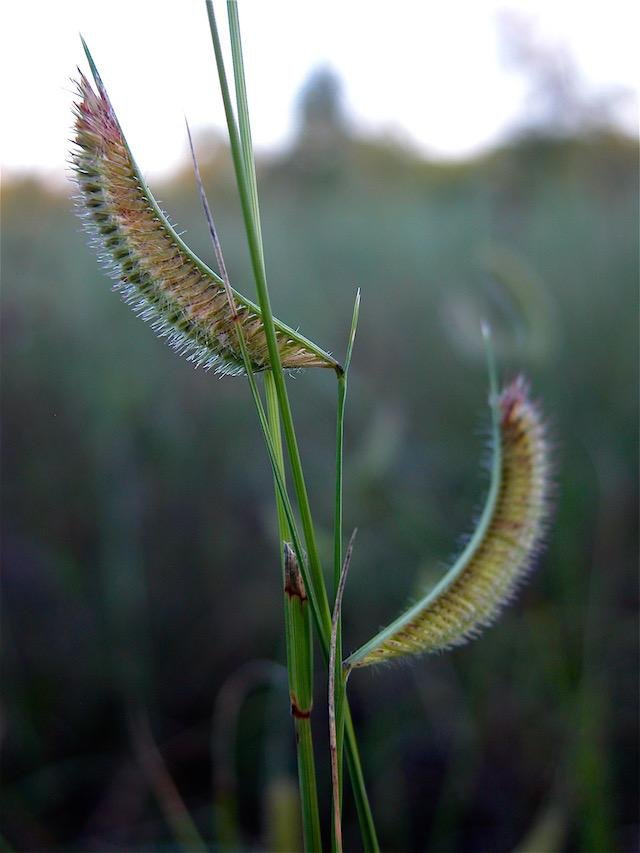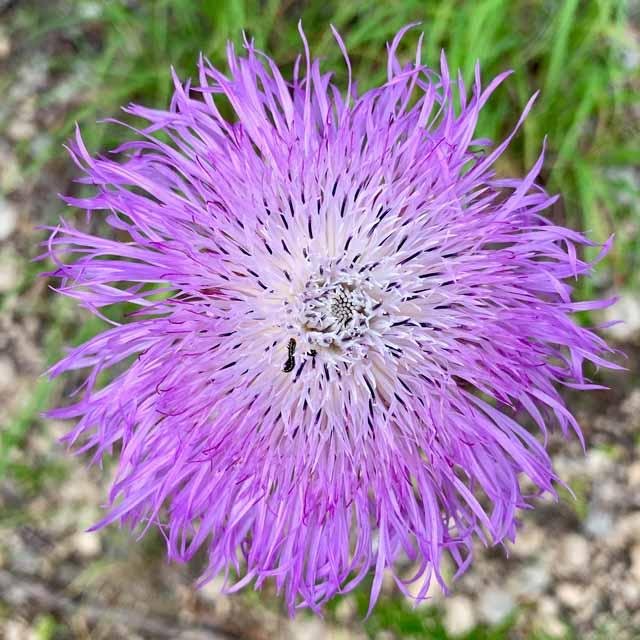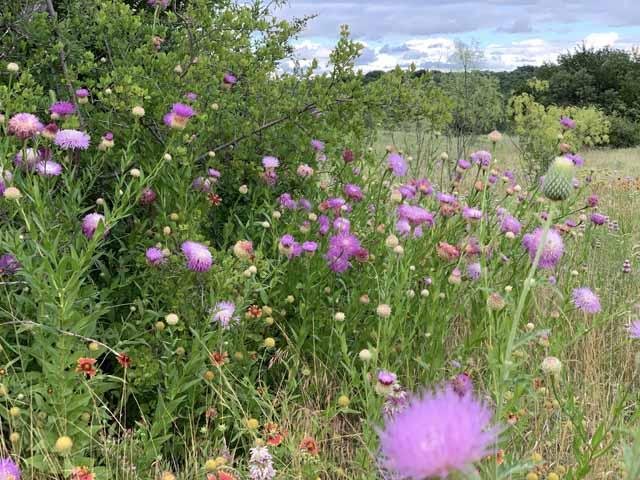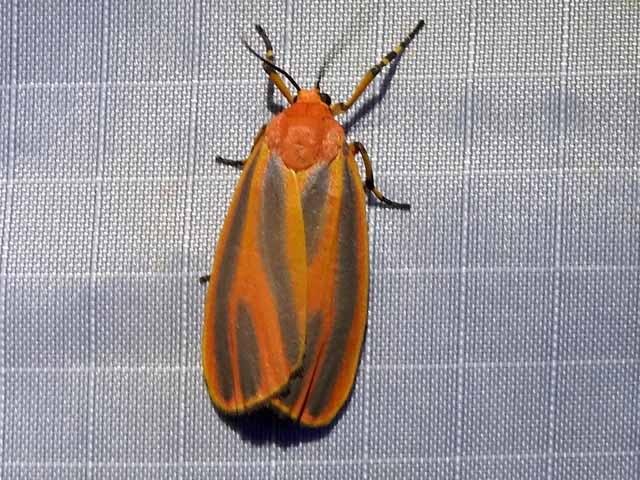Prairie Notes #151 - A Menagerie of Prairie Flora?
Prairie Notes are monthly photo/journal observations from Tandy Hills Natural Area by Founder/Director, Don Young. They include field reports, flora and fauna sightings, and more, mixed with a scoop of dry humor and a bit of philosophy.
They are available free to all who get on the FOTHNA email list.
A Menagerie of Prairie Flora?
Prairie Notes #151
July 1, 2019
01) A Menagerie of Prairie Flora?
02) Post Oak & Prairie Journal
03) Field Report - June
04) New Species - June
05) Bluebird Symposium
06) PrairieSky / StarParty News
07) Heavy Traffic
08) Amazing Insect Migrations
09) Prairie Proverb - Claude Monet
01) A Menagerie of Prairie Flora?
In my research for this newsletter I often find myself looking up names of plants, both Latin and common names. Latin is, of course, essential to ID accuracy but, common names are way more fun. Here's an example: If you want to get the attention of a group of 4th graders on a field trip to Tandy Hills you can ask, "Hey, who wants to see a Bouteloua hirsuta?" Or, you can ask, "Hey who wants to see a Hairy Grama?" See what I mean? Juvenile, I know but, it gets their attention every time. "A hairy WHAT??? (After that, we can get them to change the world!)
Recently I started paying closer attention to a pattern of, plants named after animals. I've trained myself to look for connections in words. After a few hours of iNaturalist research I discovered that, at Tandy Hills, there are least 47 of them. That got me wondering how that came about. It seems obvious to me that these names were adopted long ago when people and animals were in closer proximity, especially livestock and wild animals. I imagine that, if these plants were being named today their names may be quite different. Either way, I'll bet that some of these common names have interesting stories to tell.
Anyway, after scrutinizing all 460 species of plants listed on iNat (as of June 28), I began to see other patterns. It became a minor obsession. Here's the results of my obsession:
Body Parts List: Great Plains Ladies Tresses Orchid, Flathead Rabbit Tobacco, Skullcap, Roundhead Prairie Clover, Palmleaf Winecup, Heartleaf Peppervine, Beard-tongue, Adder's Tongue, Blackeyed Susan, Blue-eyed Grass, Eve's Necklace, Grooved Nipple Cactus, Gumweed, Heart Leaf Peppervine, Littletooth Sedge, Hairy Grama
Terrestrial/Celestial Phenomena List: Maximillian Sunflower, Sundrops, Suncups, Skydrop Aster, Fringed Blue Star, Compass Plant, Texas Yellow Star, Snow-on-the-Praire, Green Comet Milkweed, Sliverleaf Nightshade, Evening Rainlily, Evening Primrose, Heavenly Bamboo, Prairie Celestial, Shaggy Dwarf Morning-glory
Indian List: Indian Grass, Indian Paintbrush, Indian Blanket, Indian Plantain, Indian Breadroot, Chickasaw Plum
States List: Arkansas Yucca, California Brome, Carolina Buckthorn, Dakota Mock Vervain, Illinois Bundleflower, Missouri Primrose, Pennsylvania Pellitory, Texas e.t al., Virginia Pepperweed
and finally, the...
Tandy Hills Menagerie List: Adder's Tongue (Ophioglossum engelmannii), Antelope Horns Milkweed (Asclepias asperula), Bird's-eye Speedwell (Veronica persica), Buffalo-Bur (Solanum rostratum), Buffalo Grass (Bouteloua dactyloides), Carolina Snailseed (Cocculus carolinus), Catchfly Prairie Gentian (Eustoma exaltatum), Catclaw Brier (Mimosa nuttallii), Common Sow Thistle (Sonchus oleraceus), Cowpen Daisy (Verbesina encelloides), Crane's-bill (Geranium carolinianum), Crowpoison (Nothoscordum bivalve), Daisy Fleabane (Erigeron strigosus), Dog's-Tooth Violet (Erythronium albidum), Dogweed (Dysodiopsis tagetoides), False Dandelion (Pyrropappus pauciflorus), False Turkey-Tail (Stereum ostrea), False Foxglove (Agalinis densiflora), Frogfruit (Phyla nodiflora), Henbit (Lamium amplexicaule), Horse Apple (Maclura pomifera), Horseherb (Calyptocarpus vialis), Horsemint (Monarda citriodora), Horseweed (Erigeron canadensis), Jointed Goat Grass (Aegilops cylindrica), Lady Bird's Centaury (Zeltnera texensis), Lambs-Quarters (Chenopodium album), Lemon Beebalm (Monarda citriodora), Missouri Foxtail Cactus (Escobaria missouriensis), Mustang Grape (Vitis mustangensis), Ponysfoot (Dichondra carolinensis), Possumhaw (Ilex decidua), Prairie Larkspur (Delphinium carolinianum), Rabbit Tobacco (Diaperia prolifera), Redroot Pigweed (Amaranthus retroflexus), Roughleaf Dogwood (Cornus drummondii), Scarlet Spiderling (Boerhavia coccinea), Silver Wormwood (Artemisia ludoviciana), Snakeherb (Dyschoriste linearis), Sticky Mouse-ear Chickweed (Cerastium glomereatum), Stork's Bill (Erodium texanum), Southern Cattail (Typha domingensis), Texas Snakeweed (Gutierreziaa texana), Trout Lily (Erythronium albidum), Turkey Tangle Frogfruit (Phyla nodiflora), Western Horse Nettle (Solanum dimidiatum), White Fawnlily (Erythronium albidum)
Quite the menagerie, eh? You might say, "So what? It's a just a bunch of useless data." To that I say, "You want to see a Hairy Grama?"
DY
02) Post Oak & Prairie Journal
On a more serious note.....Check out the new and beautifully composed issue of, Post Oak & Prairie Journal, edited by Michael Smith and Rob Denkhaus. Included in the new issue is an essay by Don Young titled, "Tandy Hills: Land of Controversy / Wildflower Wonderland." You can read it free HERE:
03) Field Report - June
National Prairie Day, Summer Solstice and Hike Naked Day have all come and gone in June. So have the massive wildflower displays of spring which are now massive seed banks. But Tandy Hills is far from fading into the summer heat. In fact, a late June hike revealed the grasses and a select few summer wildflowers (especially, American Basketflower) are quite vigorous. However, it was critters that dominated the scene, as you will see in these photos and, they are just the tip of the prairie-berg.
04) New Species - June
When Sam Kieschnick shows up, the Tandy Hills species count goes up. It happened again in mid-June. At least 14 new species were ID'd, mostly by Sam, bringing the count up to 1210. Here's the list and pics of some of the more striking species:
June Beetle (Phyllophaga cribrosa)
Little Mesquite Cicada (Pacarina puella)
Beloved Emarginea Moth (Emarginea percara)
Eastern Grass Tubeworm Moth (Acrolophus plumifrontella)
Spined Soldier Bug (Podisus maculiventris)
Large Maple Spanworm Moth (Prochoerodes lineola)
Four-spotted Palpita Moth (Palpita quadristigmalis)
Yellow Nutsedge Moth (Diploschizia impigritella)
Mantisfly (Dicromantispa sayi)
Common Eastern Firefly (Photinus pyralis)
Diabolical Fungus Moth (Metalectra diabolica)
Scarlet-winged Lichen Moth (Hupoprepia miniata)
Large Lace-Border Butterfly (Scopula limboundata)
05) Bluebird Symposium
Texas Bluebird Society will hold a symposium Friday and Saturday, August 2 — 3, 2019, at the Midlothian Conference Center. The symposium promotes the conservation of bluebirds and teaches the public how to attract and provide quality habitat for bluebirds across Texas.
Presentations will cover topics that bluebirders, new and experienced, will find interesting and entertaining including Bluebird Basics, House Sparrow Control, Birding in Texas and Planting for Bluebirds Success. Information on Cornell Lab of Ornithology NestWatch and a Nestbox Building Workshop will also be offered.
For registration and additional information, please visit: 2019event.txblues.org
06) PrairieSky / StarParty News
The June party drew a large crowd of 50 people checking out Jupiter's moons and other celestial delights on 15 telescopes set up Fort Worth Astronomical Society members. Pam Kloepfer, of FWAS, describes below what you will see in the night sky on July 6:
"There will be lots to see in the sky in July! in the South, will be the magnificent constellation, Scorpius the Scorpion. Look for the reddish star Antares, a red supergiant. Antares is said to be the heart of the scorpion. In Greek mythology, the scorpion stung the great hunter Orion to death. Since Orion has already set in the West, it appears the scorpion is chasing him across the sky. His tail is raised with a bend of stars culminating in two stars in the stinger often called Snake Eyes. Even though we may not see it from the city, this constellation runs through our Milky Way toward the center of our galaxy. Near the stinger are two beautiful binocular targets of open clusters, M6 and M7. Jupiter will be well positioned for viewing through a telescope with its four moons in varying positions around the giant planet, and Saturn will be rising in the east. The moon on July 6 will be a waxing crescent, two days before First Quarter."
> > > Also-----New Leaf Yoga will be back for a class starting at 7 PM. Get in your yoga and stay for the star party, afterwards. < < <
07) Heavy Traffic
On a late afternoon hike in mid-June, I was heading home when I stopped to take a look back into the west. I shaded my eyes from the sun and saw a swarm of Dragonflies buzzing madly above the prairie. Watch the short video HERE: https://www.tandyhills.org/videos/heavy-traffic
Common Whitetail Dragonfly
08) Amazing Insect Migrations
The New York TImes recently published a report on insect migrations that you may find as mind-blowing as I did. Although it mentions giant, radar-visble swarms of Lady Beetles, the main insect discussed is the humble, Hoverfly, which also migrate in vast swarms which helps protect them from the escalating climate crisis. Tandy Hills has several species of Hoverfly, an insect we should all get to know better. Here's a quote of the article:
"Hoverflies provide two big ecological benefits. As larvae, they defend gardens and farms by eating aphids. As adults, they pollinate flowers as they eat nectar and pollen. I don’t think you could create a more useful insect,” said Dr. Chapman…..“I think that people will be amazed by the scale of the migrations and the significance of the ecosystem services,” said Dr. Chapman.”
Read the June 13th article HERE: https://www.nytimes.com/2019/06/13/science/animals-migration-insects.htm...
Four-speckled Hoverfly, one of several Hoverfly sepcies found at Tandy Hills.
09) Prairie Proverb - Claude Monet
“Prairie Proverb quote goes here.”
Prairie Notes© is the official newsletter of Friends of Tandy Hills Natural Area, a 501 (c)(3) non-profit organization. All content by Don Young except where otherwise noted.













































